Pith helmet
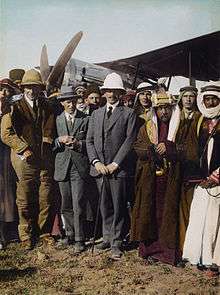
The pith helmet (Spanish: salacot), also known as the safari helmet, sun helmet, topee, sola topee or topi[lower-alpha 1], is a lightweight cloth-covered helmet made of sholapith.[1] Pith helmets were often worn by European travelers and explorers, in the varying climates found in Africa, Southeast Asia, and the tropics, but have also been used in many other contexts. They were routinely issued to European military personnel serving overseas "in hot climates" from the mid-nineteenth to the mid-twentieth century.
The pith helmet was first worn by Spanish forces during the colonial era of the Spanish East Indies,[2][3] and was later adopted by the French in Indochina due to its effectiveness in protecting from damp and humid weather.[4] Subsequently, it was commonly worn by non-indigenous officers commanding locally recruited troops in the colonial armies of France, Britain, Spain, Portugal, Italy, Imperial Germany and the Netherlands, as well as civilian officials in their territories. As such it became something of a symbol of colonial rule. Helmets of a similar style but without true pith construction continued to be used as late as World War II by European and American military personnel.
Such was the popularity of the pith helmet that it became a common civilian headgear for Westerners in the tropics from the end of the 19th century. The civilian pith helmet was typically less decorative and more practical, not as tall as the military counterpart, and with a wide brim all round. It was worn by men and women, old and young, both in formal and casual occasions, until the Second World War. After the war, the Viet Minh of Vietnam copied the pith helmet from the former French colonizer, and adopted it as their own. Today it is still widely worn by both civilians and the military in Vietnam; it is similar to the pre-World War II civilian type, but covered in jungle green cloth, sometimes with a metal insignia at the front or back.
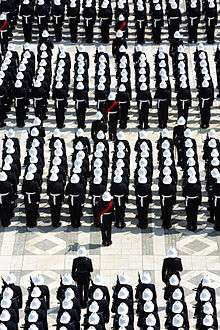
For military use, helmets of this type had begun to prove clumsy and conspicuous in the field, and after World War II they ceased to be worn on active service. Outside Vietnam the pith helmet is now worn mainly by certain units of the British, Canadian, Tongan and Thai military, and the Compagnie des Carabiniers du Prince of Monaco, on ceremonial occasions. Similar sun helmets are still worn today by some mail carriers of the U.S. Postal Service (USPS). The pith helmet has also seen use as a form of identification by U.S. Marine Corps marksmanship instructors at Parris Island, San Diego, and fleet ranges, similar to the campaign hat worn by drill instructors. These Marines wear black metal USMC insignia on the front of their pith helmet if they are marksmanship coaches, or gold if they are marksmanship trainers and block NCOs.
Definition
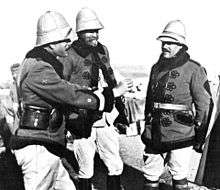
Typically, a pith helmet derives from either the sola plant, Aeschynomene aspera, an Indian swamp plant, or from Aeschynomene paludosa.[5] In the narrow definition, a pith helmet is technically a type of sun helmet made out of pith material.[6] However, the pith helmet may more broadly refer to the particular style of helmet.[6] In this case, a pith helmet can be made out of cork, fibrous, or similar material.[6] Whatever the material, the pith helmet is designed to shade the wearer's head and face from the sun.
Pith helmets were widely used by the Spanish military, which used the term salacot.
19th-century origins
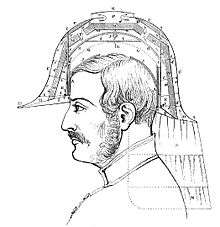
Crude forms of pith helmet had existed as early as the 1840s, but it was around 1870 that the pith helmet became popular with military personnel in Europe's tropical colonies. The Franco-Prussian War had popularized the German Pickelhaube, which may have influenced the distinctive design of the pith helmet. Such developments may have merged with a traditional design from the Philippines, the salakot. The alternative name salacot (also written salakhoff) appears frequently in Spanish and French sources; it comes from the Tagalog word salacsac (modern orthography: salaksak). During the Philippine–American War, President Emilio Aguinaldo and the Philippine Revolutionary Army used to wear the pith helmet borrowed from the Spaniards alongside the straw hat and the native salakot.
Originally made of pith with small peaks or "bills" at the front and back, the helmet was covered by white cloth, often with a cloth band (or puggaree) around it, and small holes for ventilation. Military versions often had metal insignia on the front and could be decorated with a brass spike or ball-shaped finial. The chinstrap would be either leather or brass chain, depending on the occasion. The base material later became the more durable cork, although still covered with cloth and frequently still referred to as "pith" helmet.
During the Anglo-Zulu War, British troops dyed their white pith helmets with tea for camouflage. Soon khaki-coloured pith helmets became standard issue.

While this form of headgear was particularly associated with the British Empire, all European colonial powers used versions of it during the late 19th and early 20th centuries. The French tropical helmet was first authorised for colonial troops in 1878.[8] The Dutch wore the helmet during the entire Aceh War (1873–1904) and the United States Army adopted it during the 1880s for use by soldiers serving in the intensely sunny climate of the Southwest United States.[9] It was also worn by the North-West Mounted Police in policing North-West Canada, 1873 through 1874 to the North-West Rebellion and even before the stetson in the Yukon Gold Rush of 1898.
European officers commanding locally recruited indigenous troops, as well as civilian officials in African and Asian colonial territories, used the pith helmet. Troops serving in the tropics usually wore pith helmets, although on active service they sometimes used alternatives such as the wide-brimmed slouch hat worn by US troops in the Philippines and by British empire forces in the later stages of the Boer War.
British variants
Foreign Service helmet
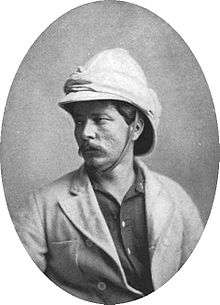
In what was then the British Empire, sun helmets made of pith first appeared in India during the Anglo-Sikh wars of the 1840s. Adopted more widely during the Indian Mutiny of 1857–59, they were generally worn by British troops serving in the Ashanti War of 1873, the Zulu War of 1878–79 and subsequent campaigns in India, Burma, Egypt and South Africa.[10]
During the Anglo-Zulu War, British troops dyed their white pith helmets with tea, mud or other makeshift means of camouflage.[11] Subsequently, khaki-coloured pith helmets became standard issue for active tropical service.
This distinctively shaped early headwear came to be known as the Colonial pattern helmet.
Wolseley pattern
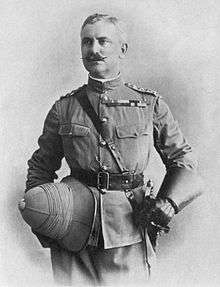
The Wolseley pattern helmet is a distinctive British design developed and popularised in the late 19th and early 20th century. It was the official designation for the universal sun helmet worn by the British Army from 1899 to 1948 and described in the 1900 Dress Regulations as "the Wolseley pattern cork helmet". With its swept-back brim it provided greater protection from the sun than the old Colonial pattern helmet, and its use was soon widespread among British personnel serving overseas as well as some Canadian units.[12]
Home Service helmet
At the same time, a similar helmet (of dark blue cloth over cork and incorporating a bronze spike) had been proposed for use in non-tropical areas. The British Army formally adopted this headgear, which they called the "Home Service Helmet", in 1878 (leading to the retirement of the shako). Most British line infantry (with the exception of fusiliers regiments) wore the helmet until 1902, when khaki Service Dress was introduced. It was also worn by engineers, artillery (with ball rather than spike) and various administrative and other corps (again with ball rather than spike). The cloth of the helmet was generally dark blue in colour, but a green version was worn by light infantry regiments and grey by several volunteer units.
With the general adoption of khaki for field dress in 1903, the helmet became purely a full dress item, being worn as such until 1914.[13]
The Home Service Helmet is closely related to the traditional custodian helmet worn since 1869 by a number of police forces in England and Wales.
The US Army wore blue cloth helmets of the same pattern as the British model from 1881 to 1901 as part of their full dress uniform. The version worn by cavalry and mounted artillery included plumes and cords in the colors (yellow or red) of their respective branches of service.
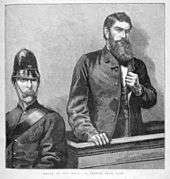
Black helmets of a similar shape were also part of the uniform of the Victoria Police during the late 19th century.
20th century
.jpg)
Military use
Pith helmets were widely worn during World War I by British, Belgian, French, Austrian-Hungarian and German troops fighting in the Middle East and Africa. During the 1930s the locally recruited forces maintained in the Philippines, (consisting of the army and a gendarmerie), used sun helmets. The Axis Second Philippine Republic's military, known as the Bureau of Constabulary, as well as guerrilla groups in the Philippines also wore this headdress.
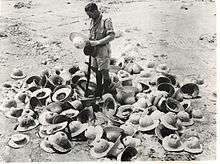
Helmets of this style (but without true pith construction) were used as late as World War II by Japanese, European and American military personnel in hot climates. Included in this category are the sun helmets worn in Ethiopia and North Africa by Italian troops, the Royal Netherlands East Indies Army, Union Defence Force, and Nazi Germany's Afrika Korps, as well as similar helmets used to a more limited extent by U.S. and Japanese forces in the Pacific Theater.[14]
The Ethiopian Imperial Guard retained pith helmets as a distinctive part of their uniform until the overthrow of Emperor Haile Selassie I in 1974. Imperial Guard units serving in the Korean War often wore these helmets when not in combat.

In the British Army a khaki version was frequently worn, ornamented with a regimental cap badge or flash. The full-dress white helmet varied further from regiment to regiment: several regiments had distinctive puggarees or hackles. On ceremonial occasions the helmet was topped with a spike (for infantry and cavalry regiments, for the Army Ordnance Corps and the Royal Engineers) or a ball (for the Royal Artillery and other corps); and general officers, staff officers and certain departmental officers, when in full dress, wore plumes on their helmets, similar to those worn on their full-dress cocked hats.[15] The British Army formally abolished the tropical helmet (other than for ceremonial purposes) in 1948.
Naval use
While not usually perceived as a headdress suitable for sea wear, a white tropical helmet was issued to personnel of the French Navy serving in the Red Sea, Far Eastern waters and the Pacific between 1922 and the 1940s.[16]
Prior to World War I the British and other navies had sometimes provided pith helmets for landing parties in tropical regions. Prior to the Second World War, Royal Navy officers wore the Wolseley helmet when in white (tropical) uniform; the helmet was plain white, with a narrow navy-blue edging to the top of the puggaree.
American naval officers could wear a pith helmet with the tropical khaki uniform.[17] Most often the pith helmet was worn by the U. S. Navy's Civil Engineer Corps.
Government use
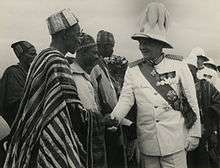
Through the first half of the 20th century, the Wolseley pattern helmet was routinely worn with civil uniform by British colonial, diplomatic and consular officials serving in 'hot climates'. It was worn with a gilt badge of the royal arms at the front. When worn by governors and governors-general, the helmet was topped by a 10-inch red and white swan-feather plume.[18] British diplomats in tropical postings, governors-general, governors and colonial officials continued to wear the traditional white helmets as part of their ceremonial white uniforms until Foreign and Commonwealth Office officials ceased to wear such dress in the late 20th century as an economy measure. The ceremonies marking the end of British rule in Hong Kong in 1997 featured the Royal Hong Kong Police aide-de-camp to the Governor in a white Wolseley pith helmet with black and white feathers, and was probably the last occasion on which this style of headdress appeared as a symbol of Empire.
Civilian use
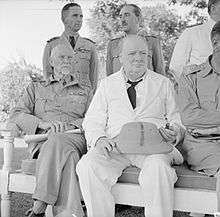
Such was the popularity of the pith helmet that it became common civilian headgear for Westerners in the tropics and sub-tropics from the mid-19th century. The civilian pith helmet usually had the same dimensions and outline as its contemporary military counterpart, but without decorative extras such as badges. It was worn by men and women, old and young, on formal and casual occasions, until the 1940s.[19] Both white and khaki versions were used. It was often worn together with civilian versions of khaki drill and/or bush jackets.

Until the 1950s there was a widespread assumption that wearing this form of head-dress was necessary for people of European origin to avoid sunstroke in the tropics. By contrast, indigenous peoples were assumed to have acquired a relative immunity.[20] Modern medical opinion holds that some form of wide brimmed but light headwear (such as a Panama hat etc.) is highly advisable in strong sunlight for people of all races to avoid skin cancers and overheating.
Pith helmets began to decline in popularity in the mid-1950s. For example, they had become relatively uncommon in Francophone African colonies by 1955, despite their former conspicuous popularity among European visitors and expatriates there during the previous decade.[21]
Comedian Richard Buckley, more famously known as Lord Buckley, wore a pith helmet so often in his act that it became his trademark.
Modern use
Commonwealth
The pith helmet is still used by a number of military units throughout the Commonwealth.
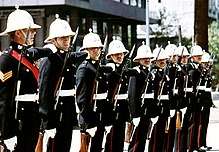
In the United Kingdom, the Royal Marines wear white Wolseley pattern helmets of the same general design as the old pith helmet as part of their number 1 or dress uniform. These date from 1912 in their present form and are made of natural cork covered in white cloth on the outside and shade green on the inside. Decoration includes a brass ball ornament at the top (a detail inherited from the Royal Marine Artillery), helmet plate and chin chain.
The Home Service helmet is still worn, as part of full dress uniform, by line infantry regiments in the United Kingdom today. Although the wearing of full dress uniform by these units largely ceased after World War I, it continues to be worn by regimental bands, Corps of Drums and guards of honour on ceremonial occasions. Such personnel are likewise directed to wear the Foreign Service helmet (either colonial pattern or Wolseley pattern according to regimental specification) when full dress uniform is worn "in hot weather overseas stations such as Cyprus".[22]
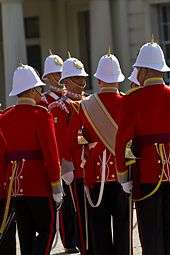
The Royal Gibraltar Regiment routinely wear the white pith helmet with a white tunic (in summer) and scarlet tunic (in winter).
Within the British Overseas Territories a white Wolseley helmet with red and white swan-feather plume is still occasionally worn by Governors of colonial territories when in white tropical uniform.[23] Since 2001 such dress has been provided only at the expense of the territory concerned and is no longer paid for by the Foreign and Commonwealth Office.[24]
The Wolseley pattern continues to be used by the Canadian Army for ceremonial purposes. Throughout the Primary Reserve, the ceremonial dress uniforms for a number of armour and infantry regiments utilize the Wolseley helmet. The Royal Canadian Regiment and Princess Patricia's Canadian Light Infantry of the Canadian Army's Regular Forces also use the Wolseley design (marked with a red and French grey puggaree respectively). In addition, the pith helmet is also worn by cadets in senior positions at the Royal Military College of Canada for certain parades and special occasions. These comprise the cadet wing commander, deputy wing commander, wing training officer, wing administration officer, squadron leaders, squadron training officers, the colour party, and the band, who is wearing a Wolseley pith helmet. The pith helmet is also used by Australian military bands, such as the Army Band and the Royal Military College Duntroon band, as well as the New South Wales Mounted Police, and the Band of the South Australia Police.
United States
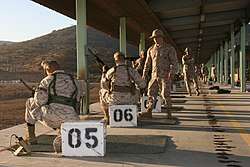
Throughout World War II, the U.S. Marine Corps, U.S. Navy, and the U. S. Army used a cheaper version of the pith helmet, called the American fiber helmet, which was made from pressed fiber.[25] Some of the helmets were printed with a camouflage pattern.[26] The two main producers of the US military fiber pressed pith helmet were the International Hat Company and Hawley Products Company. Both companies had originally designed and manufactured several civilian models made from pressed fiber with a foil lining in the 1930s, aimed to be used by laborers who worked in the hot sun, from farms to road construction to other manual labor.[27] The U.S. Marine Corps pith helmet (officially "Helmet, sun, rigid, fiber") has also seen use as a form of identification by rifle range cadres; similarly the campaign hat is worn by rifle range instructors and drill instructors.[28] White, or in some places light blue, sun helmets of plastic material but traditional design are still worn today by some mail carriers of the U.S. Postal Service, when delivering the mail on foot in hot climates such as Puerto Rico, South Carolina, Florida, Southern California, Arizona, and Hawaii, or during rainy weather. The U.S. Navy also authorized a plastic khaki sun helmet for wear by officers in tropical regions during the mid-20th century. It was decorated with a full-size officer's hat crest on the front.
A pith helmet with a feather plume is part of the uniform of the Phantom Regiment Drum and Bugle Corps, from Rockford, Illinois.
The Netherlands
A dark blue pith helmet, similar to the British Home Service helmet, is worn with the ceremonial uniforms of the Garderegiment Fuseliers Prinses Irene and the Netherlands Marine Corps.[29]
Vietnam
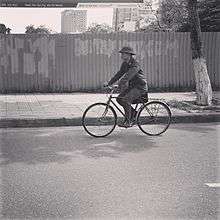
.jpg)
After World War II, the communist Viet Minh and later the People's Army of Vietnam of the North based their helmet design on the French pith helmet of the former colonial power and adopted it as their own. Today it is still widely worn by civilians in Vietnam (mostly in the North, but its use declined sharply in 2007 when the motorbike helmet became mandatory for motorbike riders). This style of headdress now appears only rarely as part of military and police uniforms. In design, the Vietnamese model was similar to the pre-World War II civilian type, but covered in jungle green cloth, sometimes with a metal insignia at the front.
Other nations
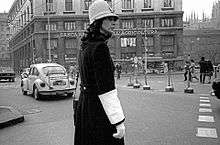
Pith helmets are worn by the Compagnie des Carabiniers du Prince of Monaco and by the Sri Lankan Police as part of their dress uniform. In the Philippines some ceremonial units such as the Presidential Security Group and the National Police use sun helmets. They are also used by the Royal Guards of the Royal Thai Army.
In the Dominican Republic, pith helmets with black pugarees were the standard duty headgear used by highway traffic officers of the national police until the beginning of the 21st century, when these units were replaced by the creation of the Autoridad Metropolitana de Transporte (AMET) corps, who were issued dark green stetson hats instead.
White Wolseley helmets are worn by mounted Presidential Guard members in Harare, Zimbabwe, during the opening of the first session of every parliament.[30]
A khaki or white pith helmet is part of the standard summer uniform of traffic officers in certain police departments in India.
Modern Italian municipal police wear a helmet modeled on the Model 1928 tropical helmet of the Royal Italian Army for foot patrols in summer. These are made from white plastic with cork or pith interior lining and resemble the British Custodian helmet, though taller and narrower.
Modern commercial models
The pith helmet has had a limited comeback in recent years, with their now novel appearance and genuine functionality making the headdress increasingly popular for gardening, hiking, safari and other outdoor activities. Today's helmets are generally available in four basic types (see below). These have changed little since the early 1900s, except that for easier adjustment the inner headband utilises hook-and-loop fasteners (e.g., Velcro) instead of the earlier brass pins. They can also be soaked in water to keep the wearer's head cool in hot weather, and feature an adjustable chinstrap towards the front.
(i) French pith helmet. This is the most functional of the helmets, with its wide brim providing more sun protection than the more narrow-brimmed variations. This helmet is mostly made in Vietnam, where the design was inherited from French colonial patterns.
(ii) Indian pith helmet. The Indian model is almost exactly the same as the French one, but with a slightly narrower brim and a squarer dome. It shares with other helmets the ventilation "button" atop the dome.
(iii) African pith helmet, or safari helmet, is a variation mainly used in savanna or jungle regions of Africa. It is generally a khaki-grey colour, with the same dimensions and shape as the Indian helmet described above.
(iv) Wolseley pith helmet. This variation of the helmet was named after (but not designed by) Sir Garnet Wolseley[31] and widely used by the British Army and Colonial civil service from 1900. The Wolseley helmet differs from other pith helmets in having a more sloping brim with an apex at the front and back. The dome is also taller and more conical than the other more rounded variations. It is the helmet often portrayed as being worn by stereotypical "Gentleman Explorers".
Controversy
The pith helmet was widely used by European colonial armies in Africa and Asia; critics have called it a symbol of colonialism.[32]
In 2018 US First Lady Melania Trump was criticised for wearing a pith helmet during her trip to Kenya. Critics noted the helmet's frequent associations with European colonialism.[33][34]
Gallery
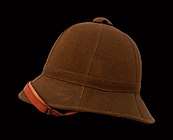 Spanish pith helmet as those worn during the Rif War.
Spanish pith helmet as those worn during the Rif War. Spiked pith helmet of the Second French Empire, in pickelhaube style, marked with the name of Ranavalona III, the last queen of Madagascar.
Spiked pith helmet of the Second French Empire, in pickelhaube style, marked with the name of Ranavalona III, the last queen of Madagascar.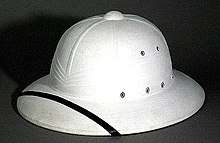
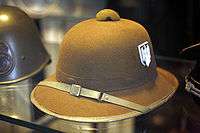 German Pith Helmet from the Second World War.
German Pith Helmet from the Second World War.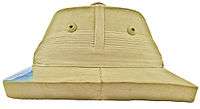 A khaki-coloured Indian-made shola-style pith helmet (shola topee) from the post-WW-II era, made from pressed sholapith and used by government employees and civilians in South Asia and the Middle East until after World War II.
A khaki-coloured Indian-made shola-style pith helmet (shola topee) from the post-WW-II era, made from pressed sholapith and used by government employees and civilians in South Asia and the Middle East until after World War II.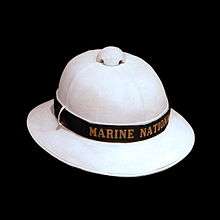 French Navy pith helmet of the early 20th century.
French Navy pith helmet of the early 20th century.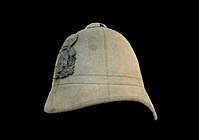 Pith helmet used during the second half of the 19th century in Spanish East Asia and later in the Spanish–American War.
Pith helmet used during the second half of the 19th century in Spanish East Asia and later in the Spanish–American War.- An NVA pith helmet worn during the Vietnam War.
- Home Service helmet of the 1st Newcastle-upon-Tyne Artillery Volunteers, 1891-1901. (Volunteer units generally had silver rather than gilt metalwork).
 Spanish Pith helmet from the War of Melilla.
Spanish Pith helmet from the War of Melilla.
See also
Notes
- ↑ The terms solar topee and solar topi are examples of folk etymology elaborations of the sola plant and are not etymologically related to "sun" or "solar"
References
- ↑ "pith helmet". Oxford English Dictionary (3rd ed.). Oxford University Press. September 2005. (Subscription or UK public library membership required.)
- ↑ Alfredo R. Roces, et al., eds., Ethnic Headgear in Filipino Heritage: the Making of a Nation, Philippines: Lahing Pilipino Publishing, Inc., 1977, Vol. VI, pp. 1106–1107.
- ↑ Antón, Jacinto (5 December 2013). "La romántica elegancia de Salacot". Archived from the original on 3 April 2017. Retrieved 3 May 2018 – via elpais.com.
- ↑ Manuel Buzeta y Felipe Bravo, Diccionario geografico, estadistico, historico de las Islas Filipinas, Charleston, South Carolina: 2011, Nabu Press, Vol. I, p. 241.
- ↑ "AskOxford:pith helmet". Archived from the original on October 6, 2008. Retrieved December 3, 2009.
- 1 2 3 Suciu, Peter. "Pith vs. Cork – Not One and the Same". Military Sun Helmets. Archived from the original on 14 January 2017. Retrieved 1 January 2017.
- ↑ "Revista de Historia Militar, nr.12, 2013, pág. 33, Ejército de Chile
- ↑ Lavuzelle, Charles. Les Troupes de Marine 1622–1984, ISBN 978-2-7025-0142-9 p.103
- ↑ "Military collection of Peter Suciu". Archived from the original on June 5, 2008. Retrieved December 3, 2009.
- ↑ Barnes, R.M. Military Uniforms of Britain and the Empire, First Sphere Books 1972
- ↑ Barthorp. Michael. The Zulu War ISBN 0-7137-1469-7 p. 21
- ↑ Chartrand, René (2012). The Canadian Corps in World War I. Bloomsbury Publishing. p. 24. ISBN 9781782009061.
- ↑ Haswell Miller, A.E. Vanished Armies, ISBN 978 0 74780-739-1
- ↑ "Quanonline.com". quanonline.com. Archived from the original on 11 January 2009. Retrieved 3 May 2018.
- ↑ Bates, S. The Wolseley Helmet in Pictures: From Omdurman to El Alamein.
- ↑ Page 346 Militaria Magazine Avril 2014
- ↑ "Uniforms of the United States Navy". Archived from the original on January 20, 2017. Retrieved February 2, 2017.
- ↑ 'Dress worn at Court', Lord Chamberlain's Office, first published 1898.
- ↑ Gunther, John. Inside Africa, Hamish Hamilton Ltd 1955, p.708
- ↑ 1911 Edition, Encyclopædia Britannica
- ↑ Mercier, Paul (1965). Van den Berghe, Pierre, ed. Africa: Social Problems of Change and Conflict. San Francisco: Chandler Publishing Company. p. 285. ASIN B000Q5VP8U.
- ↑ E.g.: "Regimental Handbook" (PDF). www.army.mod.uk. Duke of Lancaster's Regiment, 2007. Archived from the original (PDF) on 4 March 2016. Retrieved 15 May 2017.
- ↑ "New Governor : 'Challenges are crime and the economy'". The Royal Gazette. 2012-05-23. Archived from the original on 2014-03-20. Retrieved 2014-04-26.
- ↑ La Guardia, Anton (8 June 2001). "Sun slowly sets on uniform of Empire". The Daily Telegraph. Archived from the original on 20 October 2017.
- ↑ Peter Suciu (2014-02-08). "What's In a Name? The Pressed Fiber Helmet". Archived from the original on 2015-07-15. Retrieved 2015-06-07.
- ↑ Peter Suciu (2014-03-28). "The Camouflage Pressed Fiber Helmet". Archived from the original on 2015-07-15. Retrieved 2015-06-08.
- ↑ Peter Suciu (2014-11-21). "The Origin of the Pressed Fiber Helmet – In Perspective". Archived from the original on 2015-07-04. Retrieved 2015-06-08.
- ↑ "Drill Instructor School: Campaign Cover". 2009-03-28. Archived from the original on 2009-06-25.
- ↑ Kannik, Preben (1968). Military Uniforms of the World in Colour. Blandford Press Ltd. pp. 254–255. ISBN 0-71370482-9.
- ↑ "Official opening of the First Session of the Eighth Parliament". herald.co.zw. Archived from the original on 17 November 2017. Retrieved 3 May 2018.
- ↑ Carmen, W.Y. A Dictionary of Military Uniform. p. 137. ISBN 0-684-15130-8.
- ↑ George Orwell (20 October 1944). "As I Please". Trubune. Retrieved 11 October 2018.
The thin skull was the mark of racial superiority, the pith topi was a sort of emblem of imperialism.
- ↑ Rogers, Katie. "Melania Trump Raises Eyebrows in Africa With Another White Hat". The New York Times.
- ↑ Moniuszko, Sara. "Melania Trump Wears White Pith Helmet in Africa, Twitter Slams the 'Colonizer' Look". USA Today.
External links

- MilitarySunHelmets.Com : non-commercial website covering history of military sun helmets